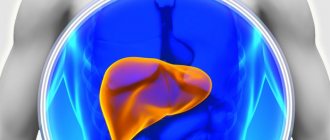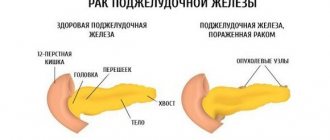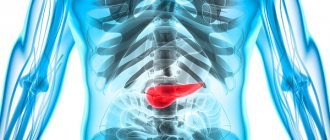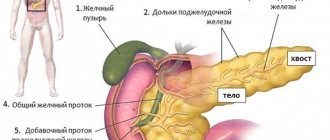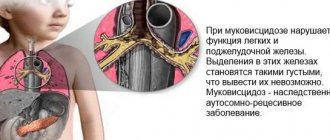Diffuse changes in the parenchyma of the pancreas - the main symptoms: Abdominal pain Pain in the left abdomen Pain in the left hypochondrium Pain in the upper abdomen Fever Weight loss Indigestion Vomiting Weakness
Sometimes, based on ultrasound results, patients are diagnosed with diffuse changes in the pancreatic parenchyma. What does the condition mean and does it pose a threat to human life and health? The answers to all these questions will be discussed in the article.
What is the disease?
Doctors divide all internal organs in the human body into 2 categories: parenchymal and hollow. In the first case, they consist of connective tissue and parenchyma. These organs include the liver and pancreas. The basis of the pancreas is a glandular structure, divided into septa and covered with a capsule.
Diffuse changes in the pancreatic parenchyma usually indicate replacement of glandular tissue with scars or fat cells
The body performs the following main functions:
- Produces enzymes involved in food digestion - amylase, trypsin, lipase.
- Produces hormones responsible for metabolic processes - glucagon, insulin, lipocaine.
The liver and pancreas are closely related. The organs have common bile ducts that remove bile and gastric juice from the body. For this reason, disturbances in one of these organs affect the condition of the other.
Causes of pathological disease
Diffuse changes - a formulation used only by ultrasound doctors. The condition is not always considered pathological; sometimes this diagnosis is due to the physiological characteristics of the human body.
Among the causes of diffuse changes, some lifestyle-related disorders can be noted:
- smoking cigarettes and drinking alcohol;
- love for sweet, fatty and spicy foods;
- drug abuse.
Predisposing factors include hereditary predisposition and the presence of chronic diseases of the digestive system.
Many diseases of the gastrointestinal tract in adults and children inevitably lead to the development of diffuse changes in the parenchyma of the liver and pancreas, which are detected using ultrasound. Among the pathologies that provoke the condition, it should be noted:
- pancreatitis in acute and chronic form;
- pancreatic fibrosis;
- lipomatosis;
- excessive deposition of iron in the structure of the gland;
- diabetes;
- atrophic and degenerative disorders in gland tissues;
- impaired production of gastric juice;
- obesity.
Symptoms
The doctor finds out any manifestations of pancreatic pathology by interviewing the patient, examining them, and comparing them with the results of blood, urine, feces, and biochemical tests.
Ultrasound results are a valuable diagnostic tool. However, they are not associated with specific symptoms and complaints of the patient.
In acute pancreatitis, severe pain of a girdling nature with nausea, vomiting, and signs of shock (pallor, tachycardia, drop in blood pressure) comes first. The patient needs intensive therapy to prevent necrosis (death) of the parenchyma and diffuse peritonitis caused by the release of enzymes into the abdominal cavity.
In a chronic course, pain occurs only during exacerbation or violation of the diet. More worrying is loss of appetite, weight loss, frequent diarrhea, bloating. Digestion is disrupted as tissue is replaced by fibrous tissue and requires increasing compensation with medications.
Fibrosis of the parenchyma in a chronic process necessarily affects the endocrine part of the gland and suppresses insulin production. Diabetes mellitus in such a patient is difficult because it depends on an irreversible process. Symptoms include: vomiting, weight loss, thirst, diarrhea.
Diabetes mellitus is accompanied by diffuse changes
The replacement of normal cells with fat cells (lipomatosis) also leads to disruption of the functions of the gland. The severity of the manifestations is related to the degree of damage to the organ, compression of the main duct and endocrine tissue.
With a degenerative process or fatty infiltration, a person may not be aware of the dysfunction of the pancreas for a long time. The pain is intermittent and moderate and is explained by other reasons. Pathology is detected only by ultrasound.
Symptoms of the disease
Diffuse changes in the pancreatic parenchyma are characterized by some symptomatic features that force patients to consult a doctor for help. Signs of a problem include:
- increased body temperature;
- vomiting;
- sudden change in blood pressure;
- discomfort in the upper abdominal cavity;
- feeling of constant fatigue and weakness;
- flatulence;
- defecation disorder;
- pain in the pancreas area.
Sometimes the condition may be diagnosed unexpectedly for the patient and not be accompanied by obvious pathological signs. In this condition, the organ can fully cope with its functions.
At the first symptoms of diffuse changes, pain in the pancreas area, impaired bowel movements and flatulence may be observed.
Treatment
The need for and scope of treatment measures is determined by the attending physician. In the absence of symptoms characteristic of diseases of the pancreas, treatment is not prescribed, but examination for the presence of cysts or tumors of the organ continues.
Treatment begins only in the presence of complaints characteristic of diseases of the digestive system and after diagnosis. Therapeutic measures in this case are aimed at correcting the underlying disease.
Treatment of acute pancreatitis involves pain relief. For this purpose, nonsteroidal anti-inflammatory drugs (diclofenac, ketotop) are used, and if there is no effect, narcotic analgesics (morphine, promedol).
To relax the spasmodic smooth muscles of the gland ducts, antispasmodics (no-spa, platifilin) are prescribed. This improves the flow of pancreatic juice containing enzymes into the intestines.
In order to reduce the production of digestive enzymes, atropine is used, as well as local therapy in the form of cold on the pancreas area.
Treatment of chronic pancreatitis outside of exacerbation is aimed at correcting the diet and taking auxiliary enzyme preparations (Creon, Festal, Mezim).
With progressive sclerosis of the pancreatic parenchyma, accompanied by an acute lack of enzymes and depletion, intravenous support for protein metabolism is provided. Nutrient mixtures of amino acids are introduced, and vitamin therapy and hormones that improve anabolism (retabolil) are prescribed.
The development of diabetes mellitus as a result of a lack of insulin requires the prescription of sugar-burning drugs and adherence to a diet.
Pancreatic fibrosis is treated with nonsteroidal anti-inflammatory drugs. In addition, digestion is supported with the help of enzymes and antioxidants. The fight against intoxication caused by cell breakdown products involves detoxification (Ringer's solution) and antibacterial therapy (penicillin drugs and cephalosporins).
Severe cases of the disease require surgical treatment followed by a course of rehabilitation.
Lipomatosis is treated conservatively with limited growth of adipose tissue. Treatment in this case consists of following a low-fat diet and combating excess body weight.
In case of pronounced growth of adipose tissue, surgical removal of lipomatous nodes is performed.
Features in children
Diffuse changes in the pancreas are often observed in children suffering from cholecystitis, gastric ulcers and colitis. The condition is often reflected in congenital anomalies of the gastrointestinal tract. Symptoms of disorders in a child:
- pain in the ribs;
- bitter taste in the mouth;
- bowel dysfunction;
- capriciousness.
Sonographic signs of pathology in children are identical to those in adults. Therapeutic measures are aimed at eliminating the cause that provoked pancreatic changes. Children are prescribed an appropriate diet and medication to treat chronic digestive problems.
Signs according to ultrasound
Ultrasound can detect 3 degrees of changes: moderate, minor and severe. Signs of minor diffuse changes are a slight change in the echogenicity of the organ and the visualization of the pancreas on ultrasound images is lighter. At this stage of development of the problem, as a rule, there are no clinical signs.
With moderate diffuse changes, the ultrasound picture shows the uneven echogenic density of the organ with areas of decreased and increased signal. Most patients with the disease complain of periodic pain in the upper abdomen, nausea after eating, and stool disorders. Laboratory examinations in this case do not reveal any violations.
The echogenicity of the pancreas is increased, it is lighter, the structure is heterogeneous
With pronounced diffuse changes, the organ is hypoechogenic and has a light color throughout the parenchyma. These signs mean that fibrous changes have begun in the structure of the gland. Echo signs of diffuse changes are not the only way to determine the problem. The disease is accompanied by vivid symptoms:
- weight loss;
- digestive disorders;
- anemia;
- general deterioration of health.
Against the background of severe disorders, diabetes mellitus develops. The described stages of changes in the organ indicate the progression of fibrotic changes in the structure of the gland due to the lack of timely and qualified treatment.
If echo signs of diffuse changes are detected, the doctor additionally prescribes additional diagnostic methods to patients:
- MRI or ;
- general blood analysis;
- Analysis of urine
The doctor can make a diagnosis and competently draw up a treatment plan based on the results of instrumental and laboratory tests. In addition to therapeutic measures, the patient is given a number of recommendations that he will have to adhere to throughout his life. Suitable medications and the regimen for their use are determined by the doctor in each individual case.
Therapy
The fight against the problem depends not only on the diagnostic results, but also on the degree of neglect of the process. With moderate diffuse changes in the pancreatic parenchyma, correction of nutrition and lifestyle is sufficient. In severe cases, preference is given to complex therapy, including physiotherapeutic measures, drug treatment and the implementation of preventive rules.
If the diffuse changes detected on ultrasound are persistent, but only slightly expressed and there are no symptoms of digestive disorders, following a diet and getting rid of bad habits is sufficient
Diet principles
Dietary nutrition involves avoiding fatty foods and including as many natural foods as possible in your diet. For any digestive problems, experts recommend split meals 5 times a day. During treatment, completely eliminate the consumption of alcohol and carbonated drinks. They try to add less spices and seasonings to dishes. The food you eat should not be too cold or hot.
Instead of soda and coffee, it is better to drink pure still water and herbal infusions based on rose hips, chamomile, and dandelion root.
Important! Herbal medicine may only be used with the permission of a physician.
To improve the digestion process, bran is added to the diet.
It is better to eat food more often and in small doses to avoid the release of large amounts of gastric juices
Drug treatment
How to treat diffuse changes? The drugs used during therapy are necessary to alleviate pathological symptoms. To combat the problem, gastroenterologists usually prescribe fermented agents, antispasmodics and painkillers. The resulting intoxication of the body is eliminated using droppers or oral solutions.
If the cause of diffuse changes is lipomatosis, then the pathology is combated using surgical methods. The doctor must remove all fatty nodes present in the pancreas. For diabetes mellitus, drug treatment is supplemented with drugs that reduce the production of glucose in the body. In some cases, patients are recommended to take insulin injections.
Note! It takes a lot of time and effort to completely cure gastrointestinal diseases. It is important to start therapy in a timely manner so that the disease does not become chronic. All therapeutic measures must be carried out by a doctor and monitored through constant testing and instrumental studies.
Diet for diffuse changes in the parenchyma
If diffuse disorders are detected in the parenchymal tissues, the patient is prescribed a diet. Its choice depends on the nature of the pathology that led to the appearance of such changes.
If you have diabetes, it is recommended to completely eliminate sugar and sweet fruits from your diet. Alcohol, spicy, fatty, salty, fried and smoked foods, canned food, sausages, carbonated drinks, seasonings and packaged juices are excluded from the menu. The daily diet is allowed to include lean meat and fish, cereals, dairy products, vegetables and unsweetened fruits. Nutrition should be adjusted depending on glucose levels.
If diseases of the pancreas and gastrointestinal tract are detected, the patient is recommended to follow a diet that is indicated for the pathology of a particular organ. In such cases, dry food and overeating are strictly prohibited. Food should be steamed, boiled or baked and taken in small portions, 4-5 times a day.
Preventive actions
The main way to prevent diffuse changes in the pancreas is to maintain a healthy lifestyle. The main provocateurs of the problem are considered to be fatty foods, alcohol, and the habit of eating “on the run.” It is also important to eat regularly to establish a certain routine for the digestive system.
Diffuse changes in the pancreas are not a disease, but a diagnosis made by a doctor based on examination results. This condition is caused by a number of other diseases and disorders present in the human body. To identify the cause of organ transformation, instrumental methods are supported by laboratory tests. Treatment of the problem is symptomatic and aimed at eliminating the root cause of the problem.
Diagnostics
Only after conducting a complete examination, a gastroenterologist is able to recommend the appointment of therapeutic measures to stop the developing pathology of the gland. Symptoms of an organ abnormality are also used to identify diffuse changes.
To know how to treat diffuse changes in the pancreas, you need to make the correct diagnosis. Diffuse changes in the gland can be diagnosed using ultrasound. Using this method, the specialist identifies an increase or decrease in tissue density, changes in homogeneity, and detection of foci of inflammation. But it is only possible to finally verify these changes using additional examinations.
Read about what tests are done to check the thyroid gland here.
The patient is given:
- Blood chemistry;
- Endoscopic diagnostics;
- The specialist can collect anamnesis based on the patient’s claims.
- It is necessary to feel the gland with your fingers
- Research using tools.
Diagnosis of such changes includes:
- Detection of enzyme concentrations and glucose levels in the bloodstream.
- General blood analysis.
- Detection of enzymes in urine and inhibitor/trypsin ratio.
- Ultrasound of the pancreas (dimensions, presence of compactions and edema, general condition of viral pathways).
- Carrying out CT and ERCP.
To identify the causes of detected changes, laboratory and functional diagnostic methods are used. From laboratory tests the following are required:
- general clinical blood test,
- biochemical (blood diastase, bilirubin, transaminases, protein and its fractions).
This method can detect acute inflammation (leukocytosis, high ESR), increased diastasis confirms pancreatitis, changes in bilirubin and transaminases (ALT, AST, GGT) indicate the presence of hepatitis.
If the diagnosis is unclear, CT or MRI of the abdominal cavity and retroperitoneal space (AP and ZP) is recommended, which can significantly increase the likelihood of determining the correct diagnosis.
In complex diagnostic cases, MRI (magnetic resonance imaging) is more often used to clarify the pathology of the abdominal organs. If for some reason it is not suitable for the patient, computed tomography is used, which has received good feedback from doctors of all specialties. The method allows you to see layer-by-layer sections of organs in various projections and identify even minor defects in the structure of tissues.
There are contraindications for CT scanning because it uses x-rays. A child cannot be sent for the study; CT is not performed on a woman during pregnancy, on an adult with iodine intolerance (if performed with contrast), as well as on pathologies of the liver and kidneys.
Echosigns
https://www.youtube.com/watch?v=rqrASgtq1Sc
Echo signs occupy a leading place in ultrasound diagnostics. The method is based on the use of ultra-high sound waves that are safe for humans. They penetrate the organ and are reflected, giving an objective picture of the tissue. The main echo signs are:
- heterogeneity of the pancreas structure due to areas of increased echogenicity,
- uneven increase in echogenicity,
- uneven expansion of the ducts,
- change in the size of the pancreas (increase due to edema in the acute phase of the disease or decrease in the final stages of the disease with atrophy and fibrosis),
- additional echo signs (presence of cysts and pseudocysts, changes in ducts).
- What is a heterogeneous thyroid nodule?
- Diffuse changes in the thyroid gland - what is it?
- Euthyroidism of the thyroid gland - what is it? Euthyroidism of the thyroid gland - symptoms and treatment
- Inflammation of the pancreas in a child: symptoms and treatment in children
